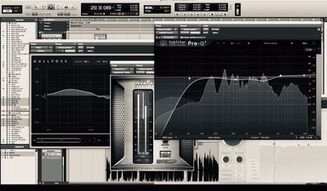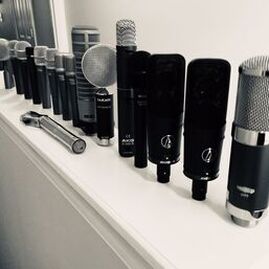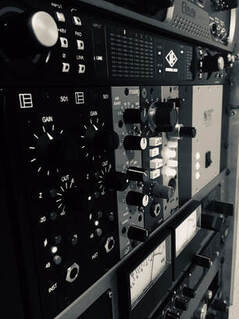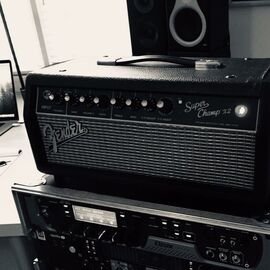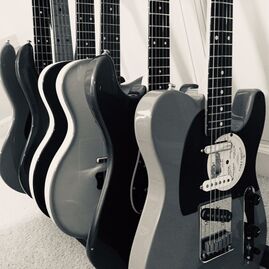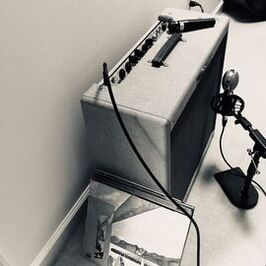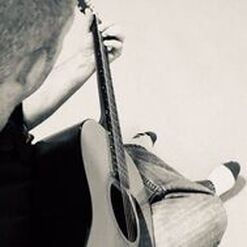The Audio Nerd Knobs Page
I wrote this page for the kind of people who enjoy a little Warren Huart on YouTube every now and again. I hope he is doing marvelously well. This is basically a blog about how I recorded this project, what I think I got right and what I got wrong. So lets get our audio nerd on.
Software & Plugins
I'm a Pro Tools guy because at my age it's the law and I don't plan to change until I can no longer afford their subscriptions. For plugins, like many of you I actually have too many to be useful, thinking I was always one more plug-in away from being able to mix. Recently, I've gone the opposite direction. I've taken to removing a majority of them from the folder to be less of a distraction. This is my current go-to list.
That said, if you were to look at my mix you might be surprised by how few plugins I'm actually using. Particularly for this project I wanted a basic in the room sound. I attempted to get it right at the source and was willing to have some overlap with so many elements active in the mix.
Top 5 mixing takeaways from this project
- Reverb: I think I got the basics mostly correct on this, like timing the decay of the snare to be out by the next hit and to roll off some of the unnatural high sizzle decay on the voice and brighter instruments. However, I still don't know how to use reverb with any panache. I think this is in part because I over arranged these tracks and there wasn't much space to let a verb add much to the texture, but no excuses. What I'm trying to do is make sure the verb not only defines the space and location in the mix but that the color and "smear" complement the tones.
- Solo Button: Still fighting the urge to make moves in solo. They all say don't do that for a reason. For me it can be hard to concentrate on one thing with everything else going on. I took baby steps toward that goal by just soloing a few elements together and mix tones in small groups of like parts or instruments.
- Compression / Dynamics: It is tempting to take a transparent limiter like the ML-1 and over apply it. You may not even hear what it is doing at all until the life starts to slip away. I would recommend trying to do as much with clip-gain as possible before compression or automation unless soft saturation is the sound you are going for. I also made the mistake of setting my attak times too fast and release times too slow on several tracks in a feeble attempt to get said element to stay put in the mix. This has the net effect of taking life out of the performance and making it sound more artificial. Managing the difference between your natural sounding dynamics in the intro and first verse before transitioning to a slightly saturated chorus is basically a magic act. I tried for weeks and I'm still not sure I got it right. But in the end I resolved to even more clip gain adjustments and automation of the dynamics plug-ins themselves, like threshold and make up gain. I think I'll be working on getting that bit right through at least my next five projects.
- Panning: You might think this is an obvious one but it wasn't for me on this project. I tried to use the LCR method as much as possible where elements are either fairly hard right ,left or straight up center. People do this to try and create as wide a stereo image as possible. When you fill in all the space between center and the edges it can often create a smeared effect limiting separation and the stereo field. The general rule is kick, snare, bass, and lead vocal always up the middle, and sometimes the main chording instrument there as well. All other characters need to find a spot somewhere side stage. But this is where it gets tricky. For this genre where the elements are all real instruments I don't like the idea of moving a character or instrument around once they have been introduced. It is not a hard rule but I just never image an accordion player getting up and moving from one side of the stage or sound field to the other naturally. The catch is when you have several instruments coming in and out throughout the arrangement. So let's imagine you have 5 elements to pan. You place the odds on the left and the evens on the right. In the first verse you have 1 and 2. In the first chorus you have 3,4 and 5. So far so good. but if at any point you want to use just your odd or your evens the mix is out of balance and the parts can clash. I struggled with this concept on several songs. Now that I've shared that I hope it doesn't bug you when you hear it.
- Over editing: Some styles and projects require machine perfect editing on timing, pitch, frankly everything, and if you want that, there is always a tool to do it. As you can tell this isn't that kind of project. I left most of the little errors and slop in there and removed only the most agredujous fouls. I did cheat a bit here and there but I wanted it to to at least sound honest. There is some auto tune on some tracks like my penny whistle, those blasted things love to go sharp and a bit on a few of the vocals but again not as much as you might think. I'm not very good at using it is another reason I didn't use it much. The point is there can be an emotional distance created when you photoshop the model too much.
Mics, when and why
|
I think I've finally graduated from being overly swayed by what some other high profile person used. I would encourage you to remember they didn't track your singer in your room. Use your own ears. Yes, we all know the SM7B was Michael Jackson's mic and Taylor Swift used an Avantone CV-12. That doesn't mean they are necessarily right for what you are tracking. I would instead think of the type of tool it is, dynamic, large or small, condenser, large or small, ribbon, etc and what unique characteristics your mic might have.
Before setting up a mic I try to think of where the instrument is going to be as if it were a character in a play. Is it the lead or a supporting role? Of course you want all your parts to sound great, but how you capture it is also going to help define how easy it is to push back or pull forward in the mix. Another metaphor I use is thinking of mics like flashlights. How much light and how white do you want that light to be on your subject. Not everything looks great in hard bright light. |
If your room is like mine and has the odd ping or a woof to it, using a super high-end sensitive mic might not be the best move. Also the more sensitive the mic the more skilled the performer needs to be. If they are moving all around, in and out, that can change the tone and levels in ways that are difficult to compensate for.
The mic I used the most for the acoustic instruments was actually a Shure Beta 57. I sometimes used an RE20 and I sometimes used a cloudlifter on both for the more delicate parts. But the idea was that a dynamic mic with a good chain behind it will get you the central essence of the instrument without too much of the room or hyping overtones like the ring of a banjo. To me, this can make it easier to control later. If it were a solo instrument I would take a different approach.
There are a number of songs that start out with just a guitar or very few instruments. In those cases I sometimes used mid-side techniques so I could have a wider image when the arrangement was open and then fade out the reflections as the arrangement got more crowded. Just a thing I tried with mixed results.
Most of Will's lead vocals were recorded with a 1998 Soundelux U195 FET. This is my most high-end mic but it isn't always my "best" mic. On some songs, in particular keys it brought out a little tinny-ness in his voice. Then I would switch to an AT 4050. I think this is an incredibly underrated mic. I think of it as the Toyota Camry of mics. It is never going to leave you stuck. If you are not the type to get hung up on brands, it is quite luxurious for the price.
One off the radar mic I would recommend is the AKG 535. These are out of production now but you can still find them used. Here is the concept and why I think they are so useful particularly for home studios, it is a condenser mic designed for live sound so it has really nice detail at close range yet captures about as much room as a 58. Whenever I would shoot out mics for parts, and I suggest you try that, this mic was consistently in contention no matter the source. I used this as my lead vocal mic on Dublin In The Rare Ould Times.
The mic I used the most for the acoustic instruments was actually a Shure Beta 57. I sometimes used an RE20 and I sometimes used a cloudlifter on both for the more delicate parts. But the idea was that a dynamic mic with a good chain behind it will get you the central essence of the instrument without too much of the room or hyping overtones like the ring of a banjo. To me, this can make it easier to control later. If it were a solo instrument I would take a different approach.
There are a number of songs that start out with just a guitar or very few instruments. In those cases I sometimes used mid-side techniques so I could have a wider image when the arrangement was open and then fade out the reflections as the arrangement got more crowded. Just a thing I tried with mixed results.
Most of Will's lead vocals were recorded with a 1998 Soundelux U195 FET. This is my most high-end mic but it isn't always my "best" mic. On some songs, in particular keys it brought out a little tinny-ness in his voice. Then I would switch to an AT 4050. I think this is an incredibly underrated mic. I think of it as the Toyota Camry of mics. It is never going to leave you stuck. If you are not the type to get hung up on brands, it is quite luxurious for the price.
One off the radar mic I would recommend is the AKG 535. These are out of production now but you can still find them used. Here is the concept and why I think they are so useful particularly for home studios, it is a condenser mic designed for live sound so it has really nice detail at close range yet captures about as much room as a 58. Whenever I would shoot out mics for parts, and I suggest you try that, this mic was consistently in contention no matter the source. I used this as my lead vocal mic on Dublin In The Rare Ould Times.
Signal Chain
At the beginning of this project I had just switched over to using a lunch box for my mic pres. I thought I wanted some variety. Now four years into this journey I don't actually need all that many options, but I learned a lot in the process. Don't get me wrong, I like having them but it's really just to nerd out more than a sonic necessity. Here is a list of the mic pres I used on this project. I would shoot out mics and pres before tracking and the ones that kept losing I would gradually rotate out. Your mileage may vary.
I also changed my interface a few time but landed on the UA Apollo 8. I do use the plugins when tracking sometimes but not often when mixing because I take my laptop with me a fair amount. Tracking with compression; I do have a Manley El-Op and I track EVERYTHING though it. Just a little needle wobble and the track is kept in check and that rich hi-fi tone is embude.
|
Tracking Guitar
Okay now we are getting into religion and I don't want to get firebombed by any zealots out there so this is just an account of what I did for this project, not what everyone should do for every project. Most of the songs started on acoustic guitar and the electrics were added later. I used several techniques and here are the pros and cons of each as I saw it.
- I used virtual amps from UA, easy, quiet, and flexible but rarely the tone I was looking for.
- Digi Eleven Rack, easy, quiet, and nearly as flexible, also generally not the tones I was looking.
- I mic'd up my 59' 4x10 Fender Bassman reissue, but at 45 watts it took so much gain to get it to do "that thing" that it was impractical for this project.
- I thought the "Goldie Locks" option for me on this was to use my Fender Super Champ x2 in 1 of 2 ways;
- Mic'd with one of the 10s" from my Bassman. (57 and/or Fathead II)
- Direct on occasion when tracking late at night.
- The Super Champ X2 is incredibly flexible and I highly recommend it for home studio recording. The models are very usable and so is the tube channel as a pedal platform.
Our Writing Process
I typically write a framework for the music of a verse and chorus, of chords and melody and I try to write twice as many as we think we'll use. I send those off to Will with some theme ideas which he may or may not use. Then he comes up with a story for the feel of the song and we start the process of fitting his words to the melody. Depending on the note or the word choice we may bend one to fit the other.
|
For the longest time I couldn't write a bridge and now I feel like it is the part of the song that reveals the the skill level of the songwriter more than anything. We do it differently every time and it tends to have the most iterations. We are not the kind of writers who bust out something in 10 minutes and think it is a finished product. Maybe it is because we can't or maybe because we over think it but that hasn't ever happened to us. Then there is the question of who is going to sing it, which typically isn't much of a question.
For writing the music I might start with just a few chords voiced rather open so that a melody has more room to sprout. If nothing comes right away I begin to change up major and minor or add a 7th to push my ear in one direction or another. If the melody wants to leave the chords, I go with it. The melody has right of way. After the melody feels solid I might go back and try chord substitutions. If the melody requires simple chords I might move the bass notes around to destabilize sections of the verse to make the chorus feel more like a home base. These are just some suggestions that seem to be working for me at the moment. |
Turf Fire Liars
Copyright © 2021
